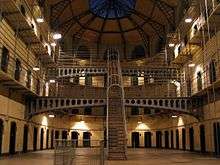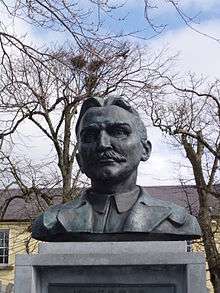John MacBride
John MacBride (sometimes written John McBride; Irish: Seán Mac Giolla Bhríde; 7 May 1868[1] – 5 May 1916) was an Irish republican and military leader executed by the British for his participation in the 1916 Irish Easter Rising in Dublin.
John MacBride | |
|---|---|
 Circa 1900-1916 | |
| Born | 7 May 1868 Westport, County Mayo, Ireland |
| Died | 5 May 1916 (aged 47) Kilmainham Gaol, Dublin, Ireland |
| Allegiance | Irish Transvaal Brigade Irish Volunteers Irish Republican Brotherhood |
| Years of service | 1913–1916 |
| Rank | Major second-in-command (4th battalion) |
| Commands held | 4th Battalion |
| Battles/wars | Second Boer War Easter Rising (1916) |
Early life
John MacBride was born at The Quay, Westport, County Mayo, Ireland, to Patrick MacBride, a shopkeeper and trader, and the former Honoria Gill, who survived her son.[2] A plaque marks the building on the Westport Quays where he was born (now the Helm Bar and Restaurant). He was educated at the Christian Brothers' School, Westport, and at St. Malachy's College, Belfast. His red hair and long nose led to him being given the nickname "Foxy Jack".[3] He worked for a period in a drapery shop in Castlerea, County Roscommon. He had studied medicine, but gave it up and began working with a chemist's firm in Dublin.
He joined the Irish Republican Brotherhood and was associated with Michael Cusack in the early days of the Gaelic Athletic Association. He also joined the Celtic Literary Society through which he came to know Arthur Griffith who was to remain a friend and influence throughout his life. Beginning in 1893, MacBride was termed a "dangerous nationalist" by the British government. In 1896 he went to the United States on behalf of the IRB. In the same year he returned and emigrated to South Africa.[2]
Participation in the Second Anglo-Boer War
He took part in the Second Boer War, where he raised the Irish Transvaal Brigade. What became known as MacBride's Brigade was first commanded by an Irish American, Colonel John Blake, an ex-US Cavalry Officer. MacBride recommended Blake as Commander since MacBride himself had no military experience.[4] The Brigade was given official recognition by the Boer Government with the commissions of the Brigade's officers signed by State Secretary F.W. Reitz. MacBride was commissioned with the rank of Major in the Boer army and given Boer citizenship.
The 500 Irish and Irish-Americans fought the British. Often these Irish commandos were fighting opposite such Irish regiments as the Royal Dublin Fusiliers and the Royal Inniskilling Fusiliers. From the hills around the besieged town of Ladysmith to the plains of the Orange Free State, MacBride's Brigade first looked after the Boers' great Long Tom gun, then fought in the Battle of Colenso and later held the rearguard, harassing Lord Roberts' cavalry as the Boer army retreated.
A Second Irish Brigade was organised by Arthur Lynch.[5] The arrival in the Irish camp of an Irish-American Ambulance Corps bolstered MacBride's Brigade.[6] Michael Davitt who had resigned as an M.P, visited MacBride's Brigade. When Col. Blake was injured at Ladysmith MacBride had to take sole command of the Brigade. Though Blake later returned for a short period he later left the Brigade to join another commando.[7] In Ireland, pro-Boer feeling, informed by Arthur Griffith and Maud Gonne formed the most popular and most fervent of the European pro-Boer movements. However, more than 16,000 Irish fought for the British against the Boers.[8]
Marriage to Maud Gonne
When MacBride became a citizen of the Transvaal, the British considered that, as an Irishman and citizen of the United Kingdom of Great Britain and Ireland, he had given aid to the enemy.[2] After the war he travelled to Paris where Maud Gonne lived. In 1903, he married her to the disapproval of W. B. Yeats, who considered her his muse and had previously proposed to her. The following year their son Sean MacBride was born. Yeats wrote to Lady Gregory in January 1905, the month MacBride and Maud separated, that he had been told MacBride had molested his stepdaughter, Iseult, who was 10 at that time.[9] The marriage had already failed but the couple could not agree on custody of Sean. Maud instituted divorce proceedings in Paris. No divorce was given but in a separation agreement, Maud won custody to the baby until age 12. The father got visiting rights and one month each summer. MacBride returned to Dublin and never saw his son again.[10] Anthony J. Jordan argues that MacBride was a much-maligned man in the divorce proceedings. He posits that on the merit of WB Yeats believing Maud Gonne's accusations against her husband, successive biographers of Yeats have treated them as factual, ignoring the verdict of the Parisian Divorce Court which found MacBride innocent. Dr. Caoimhe Nic Dhaibhid writes that "The target of Jordan's argument has been a number of biographies of W. B. Yeats, particularly Roy Foster's landmark 1997." She appears to endorse Jordan's position.[11] Donal Fallon, MacBride's recent biographer, quotes the poet Paul Durcan, the grandson of Joseph MacBride and Eileen Wilson, as believing that MacBride "was unquestionably defamed" and lays much of the blame on the "people in the Yeats-Maud Gonne Industry".[12]
1916 Easter Rising
After returning permanently from Paris to Dublin in 1905 MacBride joined other Irish nationalists in preparing for an insurrection. Because he was so well known to the British, the leaders thought it wise to keep him outside their secret military group planning a Rising.[13] As a result he happened to find himself in the midst of the Rising without notice. He was in Dublin early on Easter Monday morning to meet his brother Dr. Anthony MacBride, who was arriving from Westport to be married on the Wednesday. The Major walked up Grafton St and saw Thomas MacDonagh in uniform and leading his troops. He offered his services and was appointed second-in-command at the Jacob's factory.[14]
After the Rising, MacBride, following a court martial under the Defence of the Realm Act, was shot by British troops in Kilmainham Gaol, Dublin.

He was executed on 5 May 1916. Facing the British firing squad, he said he did not wish to be blindfolded, adding "I have looked down the muzzles of too many guns in the South African war to fear death and now please carry out your sentence." He is buried in the cemetery at Arbour Hill Prison in Dublin.
Yeats repeated Gonne’s complaints of how MacBride treated her during their marriage, as well as allegations that MacBride sexual abused Gonne's 10-year-old daughter, Iseult.
Yeats, who was jealous of MacBride for marrying Maud Gonne, also later proposed to her daughter Iseult. He gave MacBride an ambivalent eulogy in his poem "Easter, 1916":
This other man I had dreamed
A drunken, vain-glorious lout.
He had done most bitter wrong
To some who are near my heart,
Yet I number him in the song;
He, too, has resigned his part
In the casual comedy;
He, too, has been changed in his turn,
Transformed utterly:
A terrible beauty is born.
Maud Gonne wrote to Yeats, "No I dont like your poem, it isn't worthy of you & above all it isn't worthy of its subject... As for my husband he has entered eternity by the great door of sacrifice… so that praying for him I can also ask for his prayers".[15]
Legacy

In November 2016 Ciarán MacSuibhne, a member of the local St Patrick’s Drama Group wrote an amateur, three-act play detailing various stages in MacBride's life including his experiences in the Second Boer War, his marriage to and separation from Maud Gonne and the concern regarding the future of their only child, Seán, which followed. The play, which featured the poetry of Yeats, also covers the period following MacBride's execution. The opening and closing scenes of the play, in particular were described as "very moving". The character of Maud Gonne's half-sister, Eileen Wilson was played by Wilson's great-granddaughter, Bernardine Walsh MacBride. The play, which was shown in the Westport Town Hall Theatre, was described by the Mayo News as "a fitting tribute by a local drama group to a local hero".[16][17]
Notes
- Barton, Brian (23 May 2010). Secret Court Martial Records. The History Press. ISBN 9780750959056. Retrieved 29 January 2020 – via Google Books.
- John MacBride Archived 19 May 2006 at the Wayback Machine. The National Library of Ireland. Retrieved on 23 September 2007.
- McCracken, Donal P. "MacBride, John" (PDF). Dictionary of Irish Biography. Retrieved 5 August 2018.
- Jordan, Anthony J. Boer War to Easter Rising, Westport Books 2006 p.13 ISBN 978-0-9524447-6-3
- Jordan, 2006 pp.60–61.
- Jordan, 2006 p. 70.
- Jordan, 2006, p. 76.
- McCracken, Donal P. (2003). Forgotten Protest: Ireland and the Anglo-Boer War (updated and revised ed.). Ulster Historical Foundation. p. 108. ISBN 1903688183. Retrieved 11 April 2019.
- Sinead McCoole, "No Ordinary Women" (Dublin 2012), biographies
- Jordan Anthony J. The Yeats Gonne MacBride Triangle (Westport Books 2000) pp. 49–104
- Irish Historical Studies no 140. November 2010 Caoimhe Nic Dhaibhid "The breakdown of the MacBride-Gonne marriage 1904-08" No. 144 November 2010
- 16 Lives John MacBride, Donal Fallon, OBrien, 2015 p.174.
- Jordan, 2006, pp. 130–156.
- Jordan, 2006, p. 158.
- White, Anna MacBride; Jeffares, Norman, eds. (1 December 1994). Gonne-Yeats Letters. Syracuse University Press. p. 384. ISBN 9780815603023. Retrieved 29 January 2020 – via Google Books.
- News, The Mayo. "'Major John MacBride' debuts this week in Westport". The Mayo News. Retrieved 19 November 2016.
- Dr. Oliver Snr. Whyte (14 November 2016), St. Patrick's Drama Group: Major John Mc Bride, retrieved 19 November 2016
Bibliography
- Boylan, Henry, A Dictionary of Irish Biography Dublin, Gill & Macmillan 1999
- Fallon, Donal, John MacBride, Dublin, O'Brien Press, 2015
- Jordan, Anthony J. ' Major John MacBride' , Westport Historical Society 1991
- Jordan anthony J. ' Willie Yeats & the Gonne MacBrides' , Westport Historical Society 1997.
- Jordan Anthony J. ' The Yeats/Gonne/MacBride Triangle' , Westport Books 2000.
- Jordan Anthony J. ' Boer War to Easter Rising; the Writings of Major John MacBride' Westport Books 2006.
- O'Malley, Ernie, On Another Man's Wound published 1937
- Purdon, Edward, The 1916 Rising Mercier Press Ltd 1999